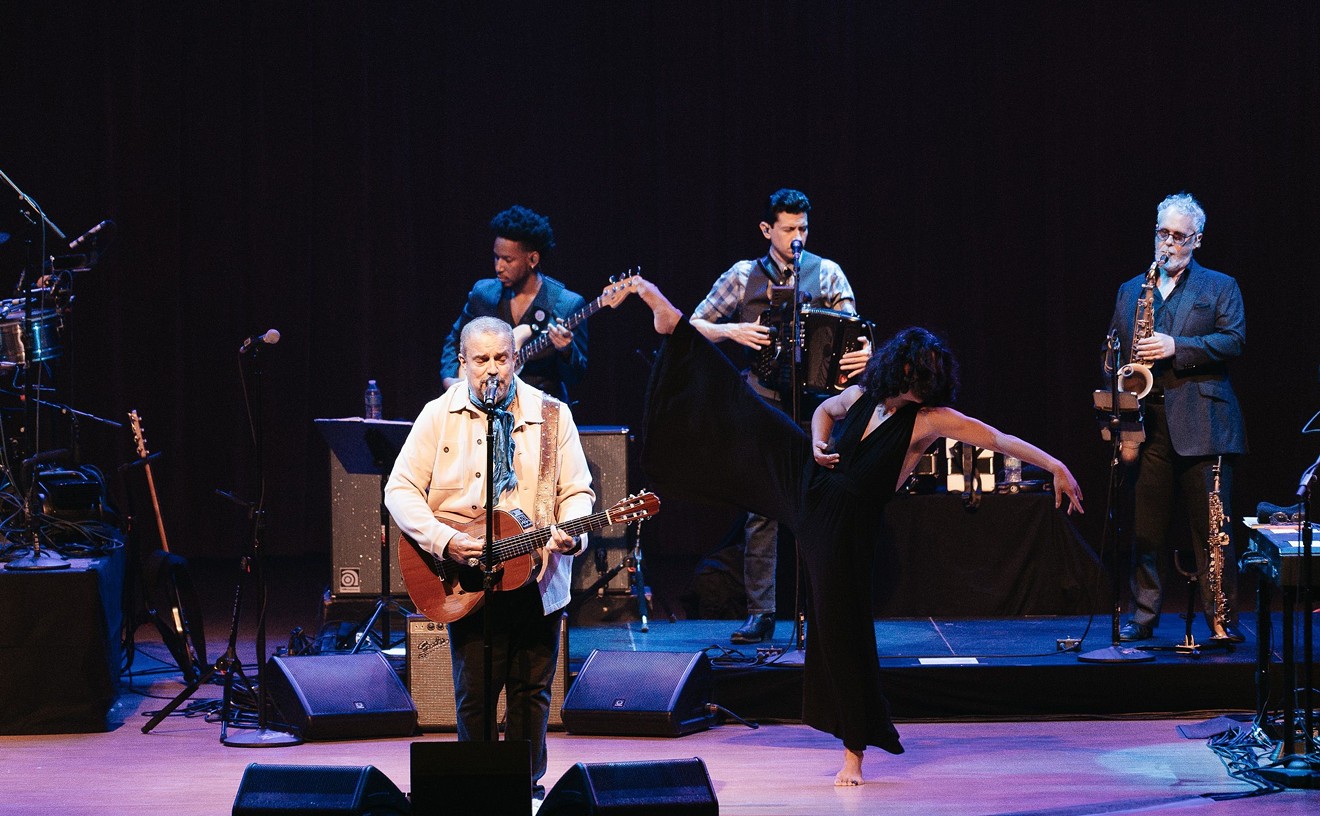That's essentially the story of 24 Hour Party People: Anthony Wilson, a visionary who is tired of abiding Manchester's second-city status, creates his own niche where cool collects like condensation. Wilson may not have been a musician or a businessman -- he was just an overgrown fan-boy -- but in 1979, he found himself in a fortuitous position for setting up his own empire. Factory and the subsequent "Madchester" renaissance couldn't have happened without a unique collision of circumstances and personalities.
The film depicts half-crazy producer Martin Hannett as the genius he was. Despite a cantankerous disposition and prodigious alcohol and drug intake, Hannett produced albums for Joy Division and Happy Mondays (which figure heaviest in Party People's summation of Factory) that gain much of their power from his erratic yet infallible sonic sense.
Wilson also had the foresight and luck to enlist Joy Division as the centerpiece of his new label -- a band the likes of which come around only every hundred years, if that. With Joy Division's pair of albums and smattering of singles -- which came to essentially define Factory -- a legacy was born.
Over here, we Yank record-store junkies soaked up the lavish packaging and obscure sounds of each Factory release (available only as high-priced imports). We didn't have a clue about Manchester's drug scene or the Hacienda, the nightclub sinkhole in which Mssrs. Wilson, Hook, Gretton, Saville, Erasmus, et al. lost so many quid. When Joy Division singer Ian Curtis hanged himself in May 1980 on the eve of the band's inaugural U.S. tour, the news didn't even warrant a two-sentence mention in Rolling Stone's "Random Notes." Factory was, and still is, a very English thing.
24 Hour Party People too briefly touched upon one of the essential elements in Factory's success: the art design of Peter Saville. With ideas lifted from Italian Futurism and Constructivism and an exquisitely sharp feel for what to leave off an album sleeve, Saville created simple, iconic beauty to match the contents. Factory's records stood out in the racks to such an extent that they had to be investigated -- and that's successful design. One Party People scene ably illustrated how Factory's long-range vision could manifest itself with crippling nearsightedness: Saville's sleeve for New Order's monumental "Blue Monday" was designed to look like a floppy disc -- not exactly a recognizable totem in the year 1983. Each record cost 79 pence to make, but Factory could recoup only 77 pence a copy, so the more copies sold, the more money the label lost. And as it turned out, "Blue Monday" went on to become the biggest-selling 12-inch single of all time.
Factory lacked promotional finesse as well. Both in Europe and America, the label relied almost entirely on word of mouth to push its products. The records in their stately Saville sleeves would be duly shipped to shops, but rarely if ever were promotional copies sent to journalists or radio stations. Factory didn't even have a record licensed in the United States until Quincy Jones signed New Order in 1985. The legend was inversely proportional to sales -- there was an inexplicable cult of obscurity that, unlike, say, that of the Residents, did not serve Factory well. Regardless, the attitude and contrarian approach to the mainstream music industry made Factory Factory.
Mick Middles, whose 1996 book From Joy Division to New Order: The Factory Story was the template for Party People, called the label "profoundly, aesthetically aloof; arrogantly self-centered... a mess of indecision and squabbling; an accountant's worst nightmare; a resting home for aesthetic waifs and strays; a breeding ground for unlikely genius; a graveyard for the trendily uninspired."
That last label I'd gladly affix to Happy Mondays, the band that made a career (and a few decent records) of being drunken, stoned, E-riddled buffoons. As Party People shows, the Mondays included one member whose sole purpose was to dance about like a goofball, and their excesses helped pull the label into bankruptcy. But for better or worse, the Mondays came to typify the exuberant energy Mancunians felt when their music seemed to be the whole world's soundtrack. Their mythic messiness and unreliability were no charade: I still have a pair of tickets to a Happy Mondays concert in July 1990. The band blew off its show that night at the I-Beam in San Francisco to stay in L.A. and party with Soul 2 Soul.
In fact, to a former fanatical Factoryphile, 24 Hour Party People and the so-called "Factory story" concentrate too heavily on Wilson's egotistical exploits and not enough on the lesser-knowns who dwell in its formidable back catalog. True, the career of white funkateers A Certain Ratio is acknowledged, and the contributions of the Durutti Column -- the first and still quintessential Factory band -- while not examined in depth, are given a token measure of respect. Wilson never wavered in his championing of classically trained Durutti guitarist Vini Reilly, who had no commercial potential whatsoever but was one of the most talented men ever to pick up the instrument.
It isn't surprising that the Durutti Column doesn't have a bigger role in the story; the band's prolific output never added up to anything but marginal sales. At least there's one celestial Durutti track included on the 24 Hour Party People soundtrack (which also includes six pivotal yet non-Factory-released songs). But someday, it would be interesting to shine a flashlight on some of the more obscure Factory offerings that played a role in the label's development. For starters, both Section 25 and Crispy Ambulance were inseparable from Joy Division in the early days: The former would perform encores with JD, and the latter's vocalist, Alan Hempsall, would regularly fill in for Curtis when he became ill. Both bands have seen their 1980s-era records reissued of late. Crispy Ambulance even mounted a reunion tour in 2000 and recorded a new album this year. Despite producing some excellent pre-acid house dance breakthroughs in the mid-'80s, Section 25 never made another record after 1988's Love and Hate, and now its Webpage pitifully informs faithful fans that new songs have been written and are ready to be recorded -- if followers can raise enough funds to buy Section 25 new instruments! Neither the music of Section 25 nor that of Crispy Ambulance, it has been reported, ever managed to gain the favor of Tony Wilson.
But Wilson was enamored of the Stockholm Monsters, Quando Quango, and the Wake -- three bands that inexplicably languished, despite having mass-appeal potential. Two label compilations, Young, Popular and Sexy (a vinyl-only release from 1987) and 1991's Palatine (the four-CD box set that served as Factory's epitaph), include their songs, along with contributions from the ones that got away. OMD released its first single on Factory in 1979 only to go on to international acclaim and sales figures immediately thereafter. In the late 1980s, the folk-inflected Railway Children (and also James) did the same thing. The list of Factory obscurities goes on and on: such vanished entities as Red Turns To..., Northside, Tunnelvision, Stanton-Miranda, Kalima, and the Shark Vegas don't even merit footnotes to the story but still helped write one of the most entertaining music fables ever.
Some of the music produced by our little South Florida labels may well be consigned to the same fate, but entrepreneurs like Artigas and Copeletti nevertheless devote as much attention to their projects as did the Manchester trend-setters. Last weekend, Artigas distributed copies of some of Spy-Fi's finest products: Machete's amazing eponymous album; a bubbly, candylike recording by Sacramento pop outfit Baby Grand; the debut from Miami's Bling Bling, on which Artigas drums; and a three-inch disc in a personalized package from Zira Lowtech -- which is actually Artigas's solo project. He zealously oversees his label as Wilson did, not caring whether he earns a dime but making sure that his stuff stands out -- musically and visually -- from the increasing glut of the CD-burner brigade. One day, Spy-Fi could even have its own high-tech office, complete with a $30,000 conference table, just like Factory did.
"That's all we can hope for," Artigas sighs.










